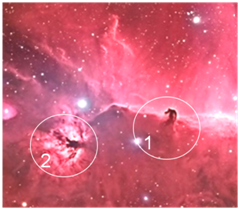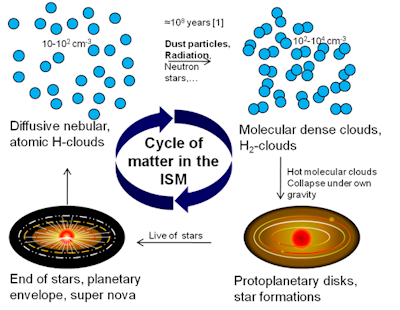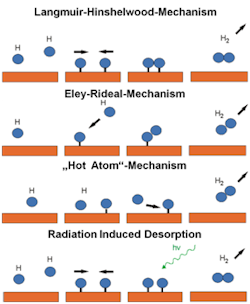
Interstellar Molecules and Surfaces in Space
In the InterStellar Medium (ISM), several elements and small molecules exist. One of the most abundant elements is hydrogen (H). It appears mainly as hydrogen clouds and nebulas. Some of the popular nebulas are the flame and the horse head nebular in the Orion region (fig. 1). Some part of these clouds consists of molecular and some part of atomic hydrogen follows an interstellar circuit (fig. 2). In this circuit atomic hydrogen clouds transform into molecular hydrogen clouds and become more and more dense. In some regions the clouds collapse and protoplanetary disks arise and develop in solar systems. After several different life states of a sun, star dust arises out of a supernova and hydrogen clouds appear again.
In this circuit one of the critical steps is the formation of molecular hydrogen. The direct recombination is not possible because of momentum violation. It is commonly accepted that a catalytic reaction on dust surfaces plays an important role in the conversion process. After a first atom is absorbed on the dust grain, different reaction pathways are conceivable (fig. 3):


Langmuir-Hinschelwood mechanism
Two H-atoms, weakly bound to the surface, meet each other after diffusion on the surface and recombine into a molecule. The molecular hydrogen desorbs from the surface due to the exothermic recombination.
Eley-Rideal-mechanism
A second atom out of the gas-phase aims for the first atom bound on the surface and recombine to a molecule.
“Hot-atom”-mechanism
The second atom out of the gas phase adsorbs and diffuses on the surface with kinetic energy. Hitting the first absorbed atom they can recombine and desorbe as molecule.
Light induced desorption
Two H-atoms in short distance to each other recombine induced by radiation. Due to the recombination energy the molecule desorbs from the surface.
Besides the elements and small molecules also complex molecules like PAH (Polycyclic Aromatic Hydrocarbons) are present in the ISM. In denser areas in the nebular the dust grain are covered with ice mantels consisting of several small molecules like CO, CO2 methanol and water. One way the production of the mentioned complex molecules takes place is the formation in these icy mantels upon radiation.
Two projects in our workgroup deal with the light induced hydrogen recombination from HOPG (graphite) and olivine.
Another project investigates the desorption mechanism and formation pathways of the bigger molecules as mentioned above.
[1] Wisps Surrounding the Horsehead Nebula, Star Shadows Remote Observatory (2006)


